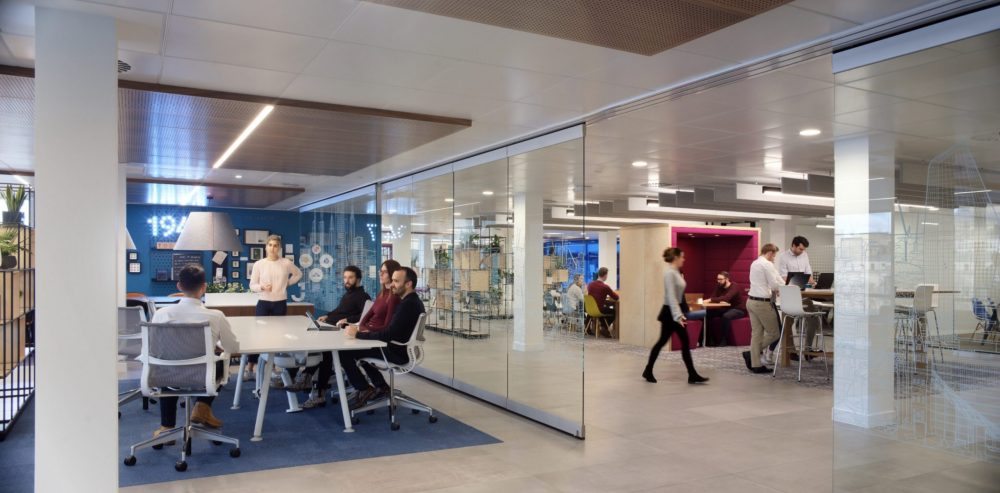Jacobs offers strategic considerations for redefining the future of work and returning to the office safely.

For many years, those of us in the Built Environment industry and specifically the design profession has talked about the “future of work,” and how the accelerated rate of change in technology, shifting demographics and employee desire for choice and flexibility would change how and where we work. We proposed new ways of working through activity and task-based work environments to support a wide range of workstyles and optimize space use. Internal and external mobility were enabled by the influence of technology. Although work styles and organizational change was experiencing an evolution, place and where work happens were not reflecting the changing nature of how many can work.
That all changed with the coronavirus pandemic.
Stay at home orders transformed business and workplace models virtually overnight. Organizations had little choice but to embrace change and accelerate the move to virtual teams, work and learning. How effective this forced pilot in distributed work is remains to be seen, but even in these early stages, employee surveys are indicating that for many people, long term flexibility of when and where to work is increasingly important and there is little appetite to return to a work place until the health crisis has some resolution.
This shift in how we work requires different skills and behaviors, new corporate policies, willingness to learn and adapt work processes and the latest technology tools. By embracing this change, we can thrive and work efficiently and effectively. The places that support work may just look a little different. We have a clear choice – maintain the status quo and restart as if nothing happened, retreat to old ways and increased space use or move beyond and shift the paradigm of work and place.
There has been much written recently about how to return staff to the physical workplace. Much of it is reactionary, tactical and facilities oriented. Single-person elevators, 6-foot circle for spacing, higher panels and more dividers just make facilities harder to maintain and make safe. What is the risk/reward in waiting while many can work effectively remotely?
A reevaluation of the value of place is needed. Each organization needs to look deep within to understand the value of place, the social networks that support how work really gets done and the needs of its people. To really understand how best to return to a physical workplace, a more strategic view, grounded in the mission, vision and values of an organization is necessary.

Purpose driven work is people centric. Place has a clear purpose. It celebrates identity, imbues culture, connects people. Redefining the future of work requires insight into business needs and work activities beginning with each organization’s unique business drivers. An activity framework supports clear decision making and purposeful choices for when, where, why and how to return staff to the workplace and expand potential opportunities for long term solutions.
Consider:
- What functions are anchored/tethered to site?
- What work modes are nice to have or better on site?
- What work modes are highly effective virtually?
- What activities should be prioritized for on site, in person work?
- How can the number of staff returning on site be limited to those whose work activities that are essential on site?
- What cadence of activities allow for the most people to benefit from onsite experience and allow for health and wellness protocols?
- What are the varied needs of staff and how can our solutions best support effectiveness and engagement?
As a multi-disciplinary organization, Jacobs thinking and expertise on the future of work scales across global/regional/cities/workplace for a macro to micro perspective on human experience, place and work driving business value for innovative client solutions. There is no one right, universal solution on how best to return staff to a physical work environment. Redefining the future of work may include a mixed, distributed model consisting of central headquarters facilities, with dispersed hubs and centers coupled with remote, virtual work. This model may allow for easier staff and customer access, less commute time, flexible working and organizational resiliency. All aspects of work must be considered from transportation, building systems, constant monitoring and measurement of health and wellness factors, sustainability, staff engagement and wellness.
The amount of information on how best to return staff to physical space is overwhelming with little data to support the proposed solutions. Focusing on values, culture, business performance, and work processes, allows organizations to create a unique yet adaptable solution to the future of work. As more is learned about the pandemic and best practices from accelerated remote work, organizations will be better positioned for long term resiliency with strategies that not only support their business but their people as well.



Interesting article. How is the Jacobs Activity Matrix to be read and how is it used?